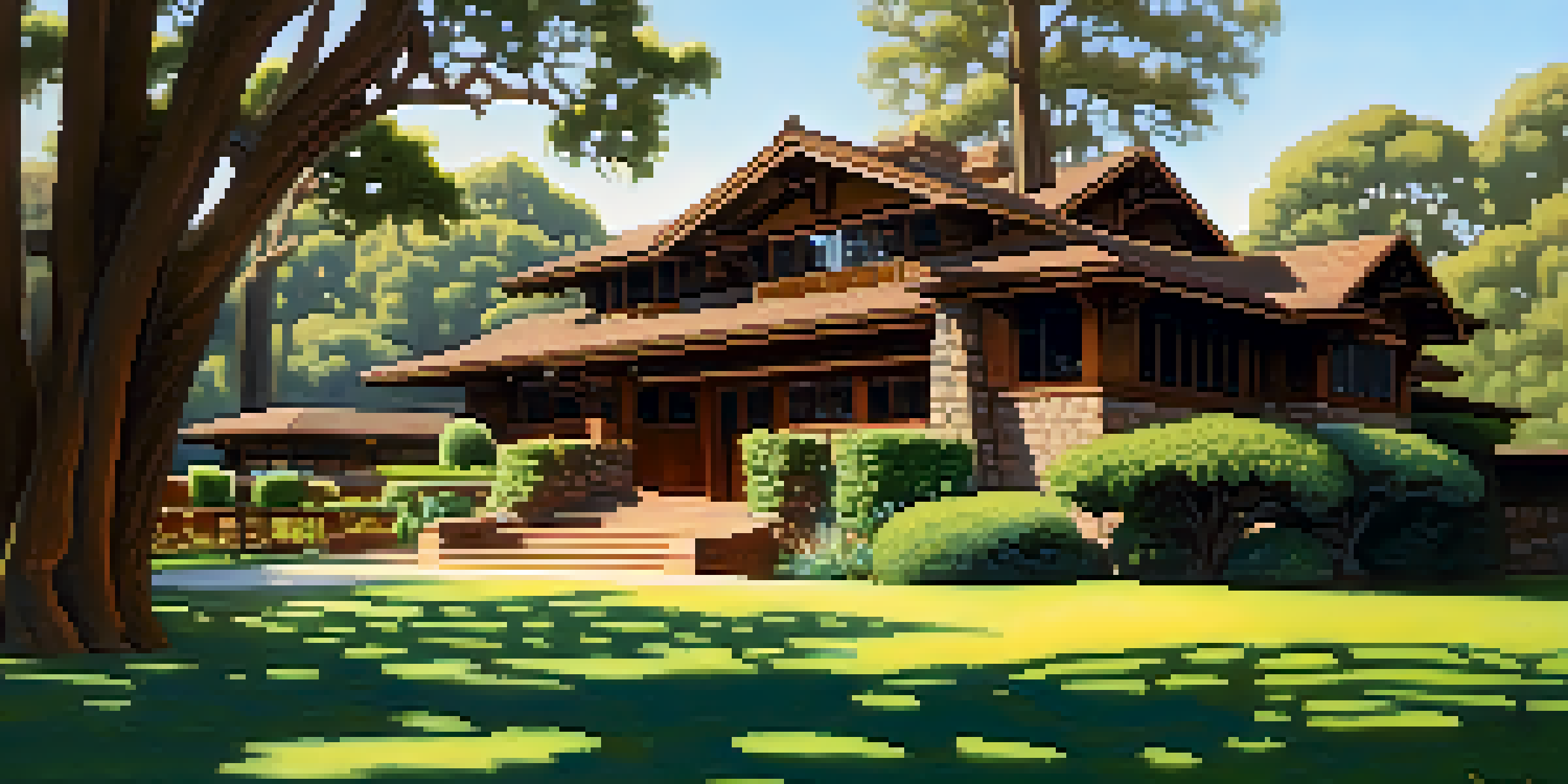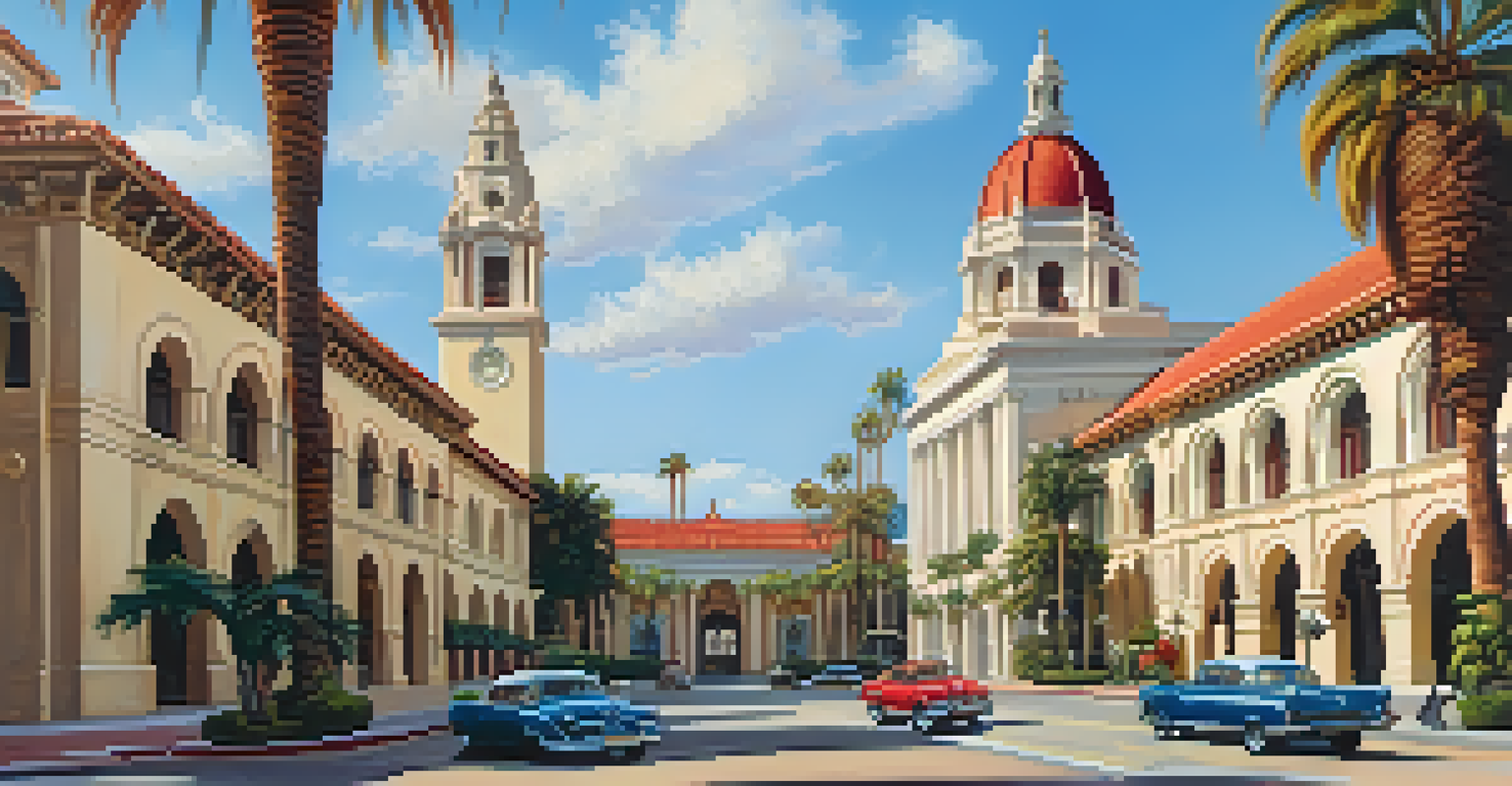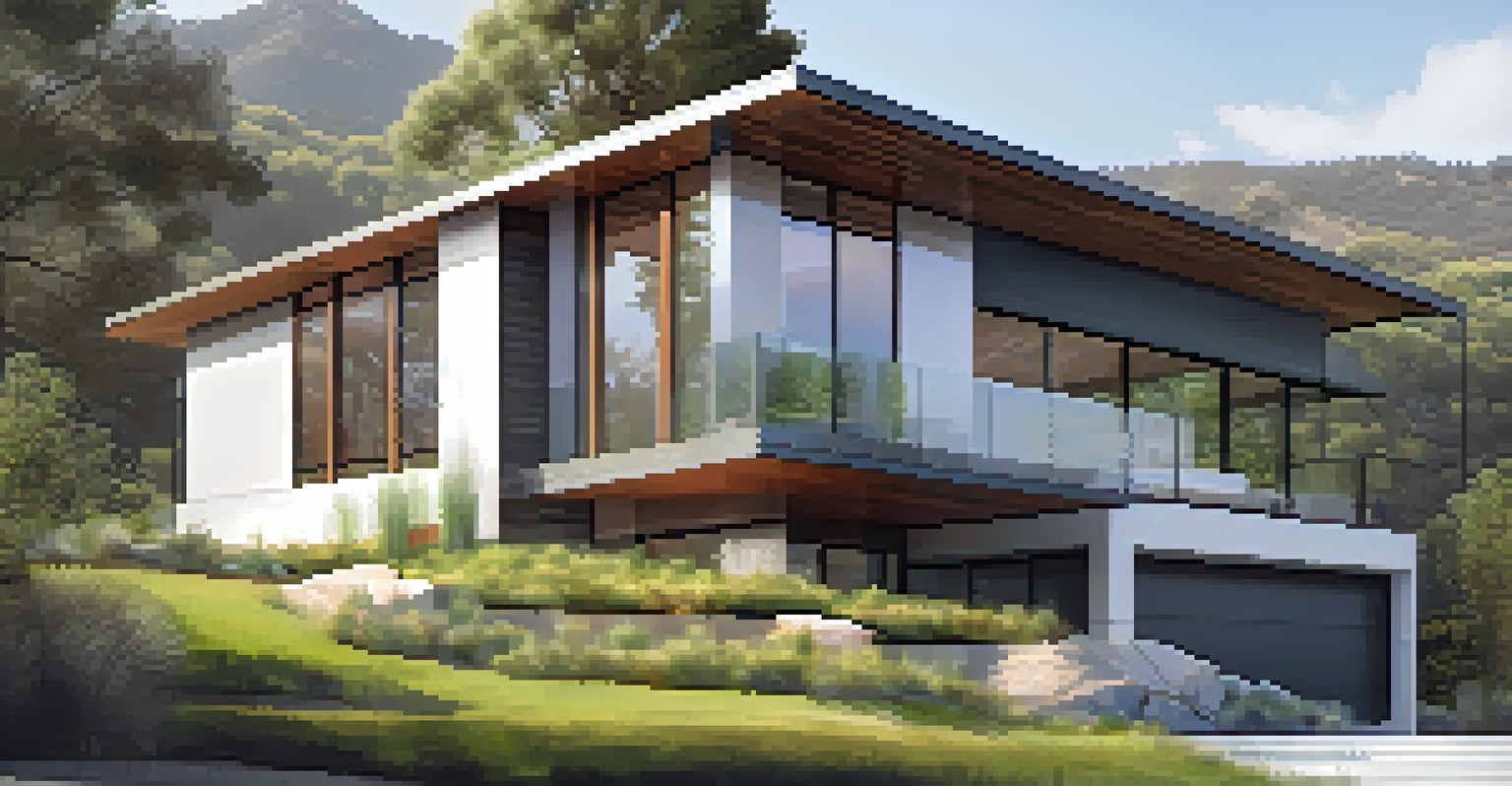Pasadena's Influence on California's Architectural Trends

The Birth of Pasadena's Architectural Identity
Pasadena's architectural identity began to take shape in the late 19th century, influenced by a mix of cultural and historical factors. The city quickly became a hub for innovative designs, blending traditional styles with emerging trends. This unique fusion created a distinctive aesthetic that would ripple across California, encouraging architects to explore new ideas.
Architecture should speak of its time and place, but yearn for timelessness.
One of the pivotal moments for Pasadena was the introduction of the Arts and Crafts movement, which emphasized handcrafted details and natural materials. This movement resonated with the local community, inspiring a generation of architects to adopt its principles. As a result, structures like the Gamble House showcased the beauty of simplicity and craftsmanship, setting a standard for future designs.
Moreover, Pasadena's architectural identity was bolstered by the establishment of the California Institute of Technology, which attracted intellectuals and artists. This influx of creative minds fueled collaborative projects, further enriching the architectural landscape. The city's commitment to innovation has made it a focal point for architectural enthusiasts and professionals alike.
The Influence of the Arts and Crafts Movement
The Arts and Crafts movement had a profound influence on Pasadena, promoting a return to handcrafted artistry in architecture. Buildings were designed to harmonize with their natural surroundings, creating a seamless blend of indoor and outdoor spaces. This emphasis on nature not only enhanced the aesthetic appeal but also fostered a deeper connection between residents and their environment.

One notable example is the aforementioned Gamble House, designed by Charles and Henry Greene. This masterpiece exemplifies the movement's principles with its intricate woodwork and handcrafted details. Such iconic structures inspired other architects throughout California to embrace similar philosophies, leading to a widespread adoption of Arts and Crafts elements in residential designs.
Pasadena's Architectural Evolution
Pasadena has developed a rich architectural identity influenced by various movements, including Arts and Crafts and Spanish Revival.
As Pasadena became a beacon for the Arts and Crafts movement, it influenced countless communities across California. The movement's ideals can be seen in various neighborhoods, where homes reflect the commitment to craftsmanship and natural materials. This architectural trend encouraged a shift away from mass-produced designs, promoting individuality and artistry.
Spanish Revival and Its Lasting Legacy
In the early 20th century, Pasadena became a key player in the Spanish Revival architectural style, which drew inspiration from Spain's rich cultural heritage. This style characterized by stucco exteriors, red-tiled roofs, and ornate details became increasingly popular throughout California. The style's romantic appeal captured the imagination of many homeowners and architects alike.
The best buildings come from the best people. If you have good people, you will get good architecture.
Pasadena's own landmarks, such as the Pasadena City Hall, showcase the elegance of Spanish Revival architecture. With its stunning arches and decorative tiles, the building stands as a testament to the beauty of this style. As architects embraced this trend, many sought to infuse their designs with elements that reflected California's unique identity, blending history with modernity.
The influence of Spanish Revival architecture extended far beyond Pasadena, impacting cities across the state. Neighborhoods adorned with Spanish-style homes became synonymous with California's architectural charm, creating a sense of place that resonated with residents. This enduring legacy continues to attract those who appreciate the blend of culture and design in their homes.
Mid-Century Modernism Takes Center Stage
As the 20th century progressed, Pasadena embraced the Mid-Century Modernism movement, which celebrated clean lines and open spaces. This architectural style marked a departure from traditional designs, emphasizing function and simplicity. Architects like Richard Neutra and Gregory Ain found inspiration in Pasadena, creating homes that echoed the spirit of innovation.
Mid-Century Modern homes often featured expansive glass walls and integration with the landscape, allowing residents to connect with nature in new ways. This design philosophy encouraged a lifestyle that celebrated leisure and comfort, making it appealing to many families. The homes became a canvas for self-expression, reflecting the evolving cultural landscape of post-war America.
Embracing Sustainability in Design
The city is now leading in sustainable architecture, incorporating eco-friendly materials and energy-efficient designs.
Pasadena's contribution to Mid-Century Modernism left an indelible mark on California's architectural scene. The city's willingness to embrace new ideas and break away from convention inspired a generation of architects and homeowners. Today, many of these iconic homes are cherished for their historical significance and continue to influence contemporary design.
Eclectic Styles: A Showcase of Diversity
One of Pasadena's most remarkable features is its eclectic architectural styles, which reflect the diverse cultural influences throughout its history. From Victorian mansions to contemporary masterpieces, the city offers a rich tapestry of design. This variety has not only shaped Pasadena's identity but also inspired architects across California to explore a multitude of styles.
For instance, the blending of different architectural elements can be seen in structures like the Pasadena Playhouse, which incorporates both Spanish Revival and Art Deco influences. Such diversity encourages creativity, allowing architects to craft unique buildings that resonate with their surroundings. This spirit of experimentation has become a hallmark of Pasadena's architectural narrative.
The city's embrace of eclecticism has also fostered a vibrant community of designers eager to push boundaries. By celebrating diverse influences, Pasadena continues to be a source of inspiration for architects seeking to create spaces that reflect the complexities of modern life. This commitment to diversity ensures that Pasadena remains at the forefront of California's architectural trends.
Sustainability and Contemporary Architecture
In recent years, Pasadena has become a leader in sustainable architecture, reflecting a growing awareness of environmental issues. Architects are increasingly incorporating eco-friendly materials and energy-efficient designs into their projects. This shift not only benefits the environment but also enhances the quality of life for residents.
Innovative designs like green roofs and solar panels have found a home in Pasadena, showcasing the city's commitment to sustainability. One notable example is the Pasadena Eco-Home, a model of energy-efficient living that inspires other communities to follow suit. This forward-thinking approach encourages architects to create spaces that are both functional and environmentally responsible.
Preservation of Architectural Heritage
Efforts to preserve Pasadena's historic buildings are crucial for maintaining its unique character amidst modernization.
As California faces pressing environmental challenges, Pasadena's focus on sustainability sets a precedent for architects statewide. The city's architectural evolution emphasizes the importance of creating spaces that harmonize with nature rather than oppose it. This commitment to sustainable design will undoubtedly shape the future of California's architectural trends.
Preserving Pasadena's Architectural Heritage
As Pasadena continues to evolve, the preservation of its architectural heritage remains a vital concern. Many historic buildings are at risk of being lost to modernization, prompting community efforts to protect these iconic structures. Local organizations work tirelessly to ensure that the city's rich architectural history is preserved for future generations.
The Pasadena Heritage organization plays a crucial role in advocating for preservation initiatives, educating the public about the significance of the city's architectural legacy. By organizing events and promoting awareness, they foster a culture of appreciation for the diverse styles that define Pasadena. This community engagement helps to ensure that architectural treasures are not only recognized but also cherished.

Ultimately, the preservation of Pasadena's architectural heritage is essential for maintaining its unique character. By valuing the past while embracing innovation, the city can continue to thrive as a center of architectural excellence. This balance between history and progress will ensure that Pasadena remains a vibrant part of California's architectural narrative.